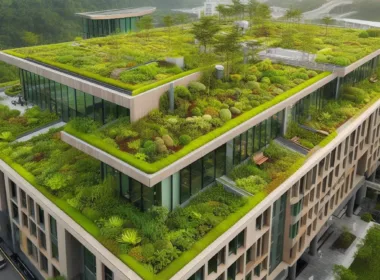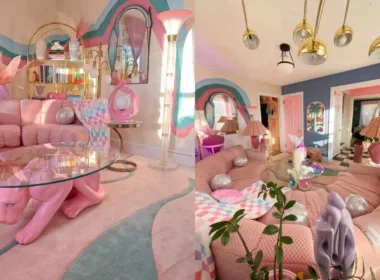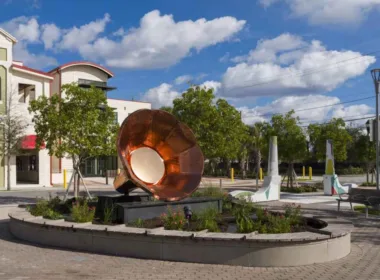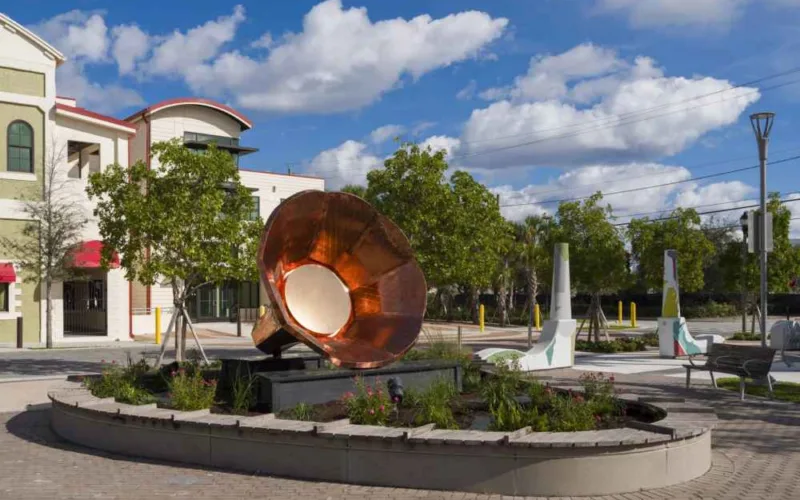“I’m tired of interiors that feel like they’re all reading off the same script,” sighs a TikTok audio as a short video pans over a door frame tiled with colorful trivets. Scroll a bit further. “I don’t care,” Judy Garland sings, underscoring a clip of disco balls with a caption that reads, “when people give their opinion on how I should decorate my home.” Video after video of bold tones, rich textures, and energetic patterns have taken over my “For You page,” and I have deep-seated interior envy. Where is this “joy aesthetic” coming from? And how do I get some?
Across social media, millennials and Gen Z are playing with more than just a pop of color. Scroll through the 158k #maximalistinteriors posts on Instagram and you’ll find extravagant gallery walls, mismatched textiles, pastel parlors, gilded brooding libraries, neon book nooks, cluttered kitchens, couches piled with flower cushions, strawberry stools, layers of linen, and more. Counter to recent scarcity-driven political shifts, the aesthetic of abundance is trending. While Pantone introduced the vivacious Viva Magenta as the 2023 Color of the Year, “dopamine decor,” “cluttercore,” and “cozy maximalism” went viral.
Maximalism is the curation of interiors filled with intentional excess, rooted in a “more-is-more” ideology. It speaks directly to today’s younger generations, thriving in every aesthetic from neo-Victorian, to avant-basic, to kindercore. Predicted as the next big interior design trend since at least 2016, these rooms are a cultural and decorative statement, marked by eclectic curation of vivid color, layered patterns, rich texture, energetic shapes, playfulness, and visual abundance.
These days, it seems everyone is not just an interior designer, but a defiant one. “Ban the beige,” captions quip. “I’m going to make my house exactly how I want it for me, with what makes me happy!” Most of these influencer accounts don’t belong to professional designers—they’re people with day jobs and a fervent passion for encouraging folks to design their own bliss-filled spaces, regardless of what others may think.
And this recent rise in maximalism is popping up beyond the For You Page–but why? Can we attribute it to designing for an increase in dopamine? Is it a passive generational rebellion, turning against past interiors as symbols of lifestyles we don’t ascribe to? Or has maximalism become a sociopolitical tool, harnessing personal pleasures to push against an omnipotent sense of impending doom?
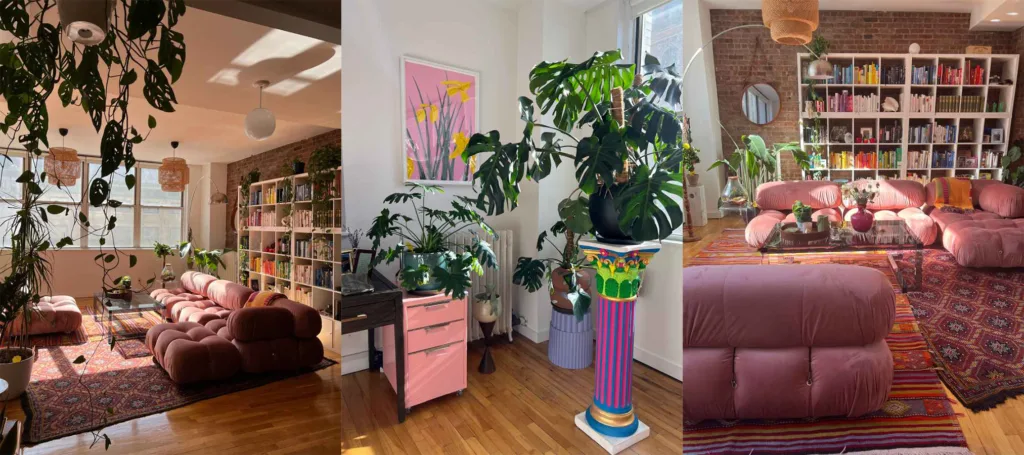
It’s design for dopamine!
“It’s all stuff that makes me happy and delighted to live in my space,” said Michelle Pham, an at-home maximalist and DIY enthusiast with over 75K followers on TikTok. We’re chatting about her home office, where a vibrating royal blue cabinet and comically large lily-of-the-valley-esque lamp radiate energy through the digital screen. Over the last few years, she and her partner have intentionally embraced childlike furniture and decor into their dream New York apartment. “When you become an adult, a lot of the things you find special are things that in your childhood you had a yearning for, so you try to replicate that idea of safety [at home] with your now modern self.”
Research shows that how we design our homes has an inextricable link to our overall happiness. The same goes for color: certain hues evoke certain moods, and what we choose to surround ourselves with impacts our mental health. As the pandemic also forced more time at home, the feel of our living spaces became increasingly essential to our wellbeing. “When we create our homes, we’re designing for recurring moments that we want to have happen in our lives,” said Ingrid Fetell Lee, author of Joyful: The Surprising Power of Ordinary Things to Create Extraordinary Happiness. In this era of generative joy, designers and non-designers are choosing bright colors and whimsical objects to bring delight into their spaces.
“I struggle with anxiety and depression, like a lot of people do, and waking up in a house full of color and all my favorite things really helps me have an easier existence,” said Jonny Carmack, the creative power behind the eclectic bubble gum vintage shop and social media account Vintage Show Pony. “I’m painting my walls pink and doing crazy stuff to my house because it’s just simple joy.”
Perhaps that’s just it: surround yourself with things you love and home becomes an oasis of happiness. Maximalism allows linens, furniture, tchotchkes, and novelties to quickly move beyond necessities to become extensions of who we are. The egg salt-and-pepper shaker and giant monstera leaf rug in my home have certainly become vital parts of my personality! It’s all design for a happier home: relishing in playful abundance, childlike wonder, and self-expression.

Let’s blame Hot Topic… or MTV.
Alternative lifestyle empire Hot Topic opened its first storefront in Montclair, California in 1989. Filled with everything an angsty teen needs to wear their heart—or favorite band—on their sleeve, the store is presented as the perfect collage of punk. The rise of MTV and the internet brought counterculture to the forefront of consumerism as a generation of “misunderstood” teens came into disposable income. Hot Topic founder Orv Madden seized this opportunity to capitalize on alternative trends and sell products designed to embrace a teens’ desire to fit into the worlds they saw on TV. Soon, malls were filled with stores serving specific subcultures. Feeling goth this week? Hot Topic has everything you need to shock your parents. Maybe you’re now surfer-chic with the shell necklace from family vacation? Try PacSun or Hollister. Entering your girl power era? Delia’s was the perfect store for all of your playful, girly needs.
“Individualism” has a template. As Web 1.0 and blogging encouraged young voices to express themselves and develop an identity, tactical counterculture capitalism forced a greater need to fit in. Driven by the promise of belonging to something bigger than ourselves, we inhaled fast fashion to become members of different cultural communities. Within the “participation trophy generations,” being able to label our style was crucial to social survival. Fads changed, and so did our wardrobes, but our identities were definable. We had a label, therefore we belonged.
The immense pressure to define our personal style evolved to a quest for the perfect interior aesthetic moniker in the 2000s and 2010s. Is your home eclectic or modern? Bohemian or traditional? Scandinavian or farmhouse chic? Find your label in big box stores and they’ll sell you a whole bedroom kit–no need to choose for yourself. Market-driven interior design classifications are designed to categorize consumers and push sales. “It’s so unimaginative to me,” mused Lee. “The industry gives you those boxes because that’s the most efficient way for them to sort you, as opposed to a framework that actually helps you understand your space so you can have agency over it.” It’s a false front, monetizing a sense of individuality through products sold to millions as if they could make you special.

Today’s maximalist interiors are, for many, in direct conflict with these carefully constructed containers. Traverse through Jonny Carmack’s home and you’ll find a hot pink panther lounging in the living room atop a rug of pink and blue cotton candy swirls, a viral strawberry table from HomeGoods nestled near a Captain Morgan green apple display case, and a watering can pouring ric-rac from the ceiling. When asked to label his aesthetic, Carmack laughed and shrugged. “Barbie-core,” “bubblegum,” “‘80s glam,” and “pop art” floated by in conversation, but we were unable to settle on one term. “I just wanted to reclaim my own identity,” he said. “Decorating your home is a direct reflection of who you are. I wasn’t allowed to be more feminine growing up, so [now] when people come into my house I want there to be an [femme] impact.” Michelle Pham, when asked to define her aesthetic, also responded with a variety of descriptors. Like many maximalists, their designs are a labelless pursuit driven by a gut feeling, object by object–retaliating against the aesthetics imposed by capitalism.
No Wealth? No Pleasure.
With a volatile job market, the impending doom of climate change, ever-inflating grocery bills, and ceaseless political tension (not to mention the ongoing pandemic), the future looks grim at best for the 40-and-unders. The 2022 Millennial Home Ownership Report from Apartment List found that over 70% of millennial renters are unable to afford purchasing a home, and 1 in 4 millennials believe they will never own property. In this world of sociopolitical anguish, no wonder people are staking a colorful claim on the spaces they can control.
Turning a house (or apartment) into a home should never be reserved exclusively for a certain financial, generational, or social demographic. “Visual culture and material culture [help construct] a world of pleasures that would have otherwise been forbidden,” London-based artist and historian Adam Nathaniel Furman told Them in March 2023. ”Pleasure is withheld for many people, and sensuality that comes from a taste or a culture that is not accepted is a form of resistance.” With the traditional housing model now well out of reach for most, designing your private space as you see fit is a potent form of self-actualization.
Rather than use nonexistent wealth, younger generations are taking ownership of their space through careful sourcing (thank you thrift stores) and DIY. Floral frames are molded out of modeling clay, kitchens retiled in vivids, disco pillow cases are hand-stitched, and furniture is repainted in bold colors. Roughly 73% of millennials are home DIYers, according to a 2022 report from Farnsworth Group. “People cope with certain things by buying kitschy decor and being more creative in their free time,” said Carmack. “Maximalism goes really hand in hand with DIY culture.” Crafting is a popular coping mechanism, and beneficial for your mental health. As we continue to live through historic events, hands-on creativity and finding joy in little things have helped people to find emotional tenancy in an uncertain physical realm, without spending money they don’t have.
Now our “defiant interior designers” are working against cold palettes defined by these perceived minimalist oppressors. “It’s easy to equate maximalism with a kind of hedonism,” said Lee. “In many ways, what we’re seeing is a counterbalancing to the stripping of sensation and variety out of our environments, [balancing] the corporatization of our environments.” A general distaste for neutral design has ballooned into a combative approach in reaction to those who came before, as Millennials and Gen Z inherit the material consequences of older generations’ political decisions. There seems to be a subtle “we’ll never be like you” mindset to younger generations’ impulse to build a prismatic refuge of joy, claiming their space one strawberry stool at a time.

Wealth and Whiteness… or Minimalism Today
Prior to the twentieth century, maximalism was the aesthetic of the rich and powerful. Opulent interiors were a signifier of great wealth, a way for people to showcase their riches. Today, the rich and powerful are decidedly minimalist. Peer inside Kim Kardashian’s $60 million mansion for a glimpse of pristine white and beige everything that only she could afford to keep clean.
Clearing the countertop for a moment, minimalism arguably holds parallel appeal to maximalism in the home. Thanks to reality show designers like Joanna Gaines, the Home Edit, and Marie Kondo, minimalism spurred a need for joy-filled spaces. Having less places more value in what you do have, each item bringing more joy into your life. Sleek lines, neutral tones, natural surfaces, and clean countertops create a spa-like sensation in a peaceful retreat from the cacophony outside. Originating in the late 1960s, minimalism originally fought against the self-expression of smaller maximalist movements to prioritize simplicity, valuing essential elements of an art form over emotions. Like maximalism, minimalism is based in intentionality, but one inspired by simplicity over abundance. It makes your space a sensible, impersonal aesthetic rest in the chaotic symphony of the world.
At the same time, minimalist corporate environments like the 2022 Skye Design Awards winner Goodman Business Park emphasizes stone gray, stark lines, optimization, and doing more with less. Minimalism’s tendency towards simplicity and prioritizing only things of immediate value appeals to companies as a method to reduce distraction and streamline systems in the workplace. Brutalism took minimalism to the extreme following World War II, as stark structures featuring clean lines and natural materials with no ornamentation became associated with totalitarianism and oppressive power, often designed by Italian and German fascist regimes. As political tension rises, it’s no wonder burnt-out zillennials and many others are turning away from stark, overbearing aesthetics toward the wonderful world of color.
So Why Maximalism?
It’s easy to speculate why this wave of maximalism seems to be sweeping the nation. For some, it’s about curating an oasis of security and comfort. “I’m painting my walls pink and I’m doing all this crazy stuff to my house because, outside these doors, the world is so ugly— because I just want to be in a safe space,” Carmack lamented. For others, it’s infusing their world with laughter. Pham, a millennial whose work life is intertwined with Gen Z, sees it as “a rebellion against what ‘luxury’ is supposed to look or feel like,” renouncing eras of pristine, clean design.
Perhaps it’s driven by nostalgia. Maybe it’s a coming-of-age rebellion. Maybe it’s a desire to connect to something we never had, or a need for dopamine. Or it’s simply the poor man’s aesthetic hedonism. Whatever the impotence, maximalism is at the forefront of a joy revolution. As young people continue to build pleasurable fortresses between themselves and the world, I will keep scrolling through social media ready to catapult through the screen. Whether neon or noir, each of these spaces are happy at their core, radiating a joy that feels personal to each of the humans residing within them. Maybe that’s all this is really about.
Brooke Viegut is a researcher, experience designer, theater artist, speaker, and professional merrymaker. Brooke co-hosts “so there’s this…” a podcast about design that disappoints. She is dedicated to the “art of having a good time,” studies objects & experiences that bring us joy, and is the owner of a rapidly growing collection of silly things. She is the author of Anonymous Intimacy (coming 2023) and holds an MA in Design Research, Writing, and Criticism from the School of Visual Arts.

